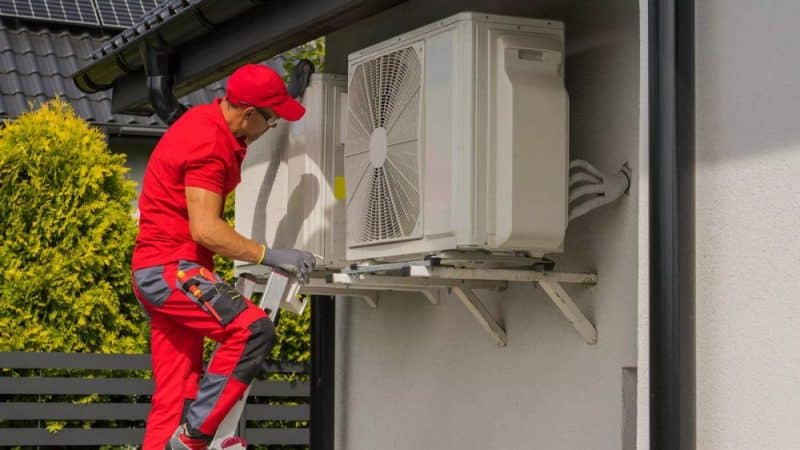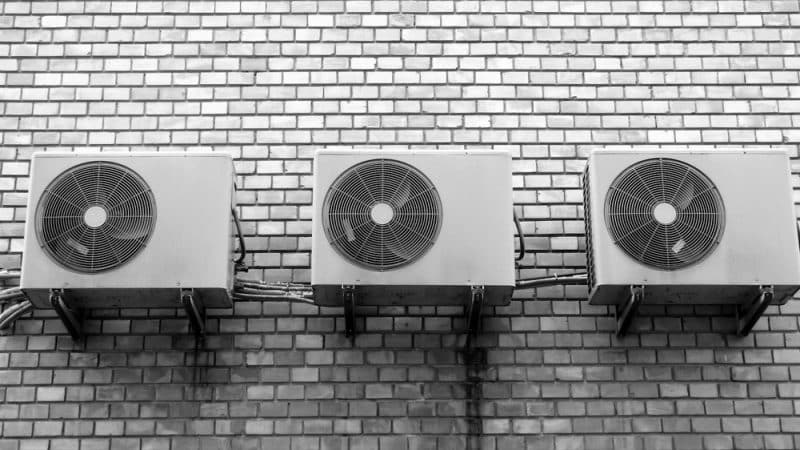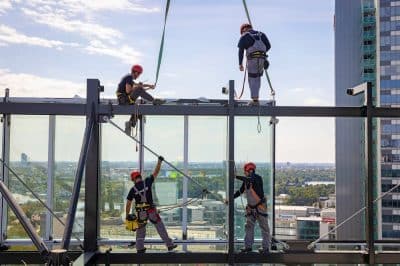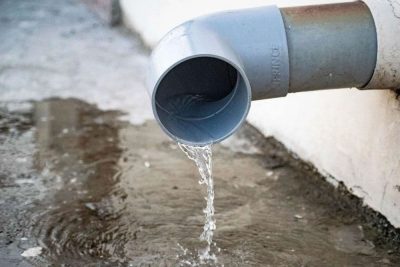
Understanding the inner workings of your home’s heating, ventilation, and air conditioning (HVAC) system puts you in the driver’s seat when troubles arise needing diagnosis. This guide breaks down need-to-know basics about typical HVAC component functions, commonly occurring mechanical issues, handy do-it-yourself HVAC maintenance pointers, discernible signals professional assistance proves necessary, and smart contractor vetting. These steps ensure household comfort and peace of mind all year long. Let’s dive into appreciating HVAC care at a glance!
Components of an HVAC System
An HVAC system consists of several key components, each playing a specific role:
- Thermostat: The control center interfaces with electrical equipment managing desired temperature settings either digitally or using mechanical dials adjusting triggers calling for heating/cooling based on indoor readings. Location impacts accuracy, so placing the thermostat away from direct sunlight, drafts, and heat sources ensures precise readings and efficient system operation.
- Furnace/Heat Pump: Burners or electrical elements produce warm air forced through ducting vents meeting seasonal winter or mild summer night thermostat demands. Efficiency differences and fuel type variations matter significantly. Regular maintenance of burners and heat exchangers can prevent malfunctions and increase the system’s lifespan.
- Air Conditioner: Chills air through refrigerant gas compression cooling cycles, with cooled air distributed through interconnected ductwork during peak hot months or sporadic overheated indoor spikes. Keeping the condenser coils clean and ensuring adequate refrigerant levels are critical for optimal performance.
- Ductwork: Networks of sheet metal tubing or flex hoses direct conditioned airflows under static pressure transfers reaching room vents, emitting set temperatures keeping spaces livably uniform. Insulation fights envelope heat transfer and moisture. Regular inspection and sealing of ductwork can improve efficiency and prevent energy loss.
- Air Filters: Trap particulate entering returns preventing fouling of key furnace/blower/evaporator components. Different ratings catch microscopic specks measuring filtration potentials, balancing pressure drops determining when replacing filters makes sense optimizing airflow. Higher MERV-rated filters can trap smaller particles, improving indoor air quality but may require more frequent changes.
- Ventilation System: Ensures that fresh air circulates throughout the home, maintaining indoor air quality by removing stale air and introducing fresh, clean air. This component often includes exhaust fans, air intake vents, and sometimes energy recovery ventilators (ERVs) to maintain efficiency. Proper ventilation helps prevent moisture buildup and reduces the risk of mold and mildew growth.
Common HVAC Problems
Some of the most common issues include:
- Dirty Air Filters: Reduces airflow efficiency and wastes utility output. Monthly inspection helps with maintenance. Consider upgrades trapping more allergens. A dirty filter can cause the system to overheat and shut down, leading to potential damage and costly repairs.
- Thermostat Malfunctions: Settings get out of calibration or mechanical components fail, needing replacements to maintain control integrity and ensure systems react correctly. Modern programmable thermostats can offer more precise control and energy savings if correctly programmed.
- Refrigerant Leaks: Critical evaporator gas escapes externally causing chill loss until technicians locate and reseal pierced lines, fully recharging units back to peak efficiency specifications. Low refrigerant levels can also cause the compressor to overheat and fail.
- Clogged Drain Lines: Blocked condensate removal tubes cause drainage backups, risking electrical shorts and indoor water leaks, eventually requiring cleaning or replacement. Regularly flushing the drain line with a vinegar solution can help prevent clogs.
- Electrical Control Failure: Defective control boards, wiring faults, or corroded connections develop operational glitches preventing system responses. Professional diagnoses help troubleshoot root causes pinpointing repairs. Ensuring tight and clean connections can prevent many electrical issues.
- Blocked Vents and Registers: Furniture, drapes, or debris can obstruct air flow, making the system work harder and less efficiently. Regularly checking and clearing these obstructions can prevent strain on your HVAC system. Maintaining at least a few inches of clearance around vents ensures proper airflow.
- Blower Motor Issues: The blower motor circulates air through your system. Over time, wear and tear or lack of lubrication can cause it to fail, leading to inadequate heating or cooling. Periodic inspection and lubrication of the blower motor can extend its life and improve system efficiency.
DIY Maintenance Tips
Homeowners can perform certain maintenance tasks to keep their systems running smoothly:
- Regular Filter Replacement: Mark calendars to check filters monthly and swap out upgraded models annually to stop dust buildup damaging parts and lowering energy bills in the long run. Using high-quality filters can improve indoor air quality and reduce strain on the system.
- Cleaning Vents and Registers: Vacuum floor/wall vents plus vent covers, eliminating visible debris around intake openings to keep duct flows obstruction-free, helping airflow. Occasionally removing and washing vent covers can further reduce dust buildup.
- Checking Thermostat Settings: Verify programmed temperatures match needs and adjust accordingly. Lower heating levels save money when away, while moderate cooling settings prevent overworked compressors and unnecessary expenses. Ensuring the thermostat is set to the correct mode (heating or cooling) for the season can prevent operational issues.
- Inspecting Outdoor Units: Ensure outdoor inverter/condenser fan blades or heat pump components stay debris- and leaf-free with adequate perimeter spacing for sufficient airflow across coils. Trimming vegetation around outdoor units ensures unobstructed airflow and prevents potential damage.
- Inspecting Insulation: Check the insulation around ducts and in the attic. Proper insulation helps maintain desired temperatures, reducing the workload on your HVAC system. Adding insulation in critical areas can improve efficiency and comfort.
- Sealing Leaks: Inspect ducts for leaks and seal them with duct tape or mastic sealant to prevent conditioned air from escaping and to improve efficiency. Regularly checking for and sealing leaks can save energy and reduce utility bills.
- Monitoring Energy Bills: Keep an eye on your energy bills. A sudden increase might indicate your HVAC system is not running efficiently and could need maintenance or repair. Comparing bills from year to year can help identify inefficiencies and prompt timely action.
When to Call a Professional
Certain HVAC issues necessitate the expertise of a professional technician:
- Strange Noises: Clicks, hisses, whines, or grinding sounds signal emerging motor, fan, or compressor failures requiring prompt inspections to prevent further system damage. Ignoring unusual noises can lead to more severe damage and costly repairs.
- Uneven Heating or Cooling: If some rooms vary uncomfortably in temperature, it indicates duct flow or unit output abnormalities. Seek professional opinions to uncover root causes. Balancing airflow and addressing duct issues can enhance overall comfort.
- Frequent Cycling: Units continuously turning on/off prematurely likely suffer from refrigerant charges needing replenishment, faulty sensors, or developing compressor failures necessitating repairs. Frequent cycling also increases wear and tear on the system, shortening its lifespan.
- Visible Leaks or Moisture: Wet floor areas around equipment, water dripping from vents, or exterior rust streaking from strips of damaged condenser coil insulation necessitates sealing leaks ASAP to stop air contaminations that breed dangerous mold over time or shorts risking fire hazards developing.
- Electrical Sparks or Burning Smells: Shut systems down immediately and make emergency service calls. Consider temporary accommodations if repair delays are expected to ensure household safety. Electrical issues pose significant fire risks and should never be ignored.
- Total Equipment Failure: Technicians perform detailed failure analyses to determine if entire unit or partial component replacements make more sense based on repair/replacement cost ratios. Comprehensive evaluations help make informed decisions about major repairs or replacements.
- Poor Air Quality: If you notice increased dust, allergens, or musty odors, it may be time for a professional to inspect your HVAC system and ducts for proper filtration and ventilation. Addressing air quality issues can improve health and comfort.
Choosing the Right HVAC Contractor
Selecting a reputable HVAC contractor is crucial for quality repairs and maintenance. Here are some of the factors you should consider when looking for professional HVAC repairs:
- Credentials and Licenses: Require all technicians to be certified, demonstrating industry competence, insurance coverage, and compliance with legal operating standards. Verified credentials ensure you are working with qualified professionals.
- Experience: Number of years managing equipment brand lines and models matching yours adds familiarity and better diagnosing capabilities. Experienced contractors are more likely to provide reliable and efficient service.
- Customer Reviews: Check independent online review platforms and request residential reference contacts to confirm satisfactory service delivery. Positive reviews and testimonials indicate a contractor’s reliability and customer satisfaction.
- Service Contracts: Multi-year preventative maintenance agreements offering periodic tune-ups identify emerging part degradations before failures happen, plus provide discounted emergency/replacement services. Long-term contracts can offer peace of mind and cost savings.
- Response Times: Ask about average response times for non-emergency and emergency issues to understand logistics and technician availability. Quick response times are crucial during extreme weather conditions.
- Detailed Invoices: Ensure comprehensive service, labor, and part line items on invoices matching quoted estimates, avoiding budget surprises. Transparent invoicing helps you understand what you are paying for and ensures there are no hidden costs.
- Warranty and Guarantees: Inquire about warranties and guarantees on both parts and labor. Reputable contractors will offer assurances on their work and the equipment they install. A solid warranty provides protection against future issues.
- Transparency and Communication: A good contractor should be transparent about their processes, provide clear explanations, and be willing to answer any questions you might have. Open communication builds trust and ensures you are informed throughout the service process.
Benefits of Regular HVAC Maintenance
Investing in regular maintenance offers several benefits:
- Improved Energy Efficiency: Clean parts operate with less electricity/gas, getting maximum mileage from fuel types used, and potentially reducing bills by up to 20% over time. Efficient systems consume less energy, leading to significant cost savings.
- Enhanced Indoor Air Quality: Replacing filters and anti-microbial evaporator cleanings reduce allergy-triggering mold and bacteria, ensuring healthier air circulation. Improved air quality can lead to better health and comfort.
- Extended Equipment Lifespan: Routine preventative HVAC servicing prevents premature breakdowns, potentially doubling the system’s functional life. Long-lasting equipment reduces the need for costly replacements.
- Improved Home Valuation: Documented upgraded HVAC systems can increase home value, impressing potential buyers and translating into higher appraisal values. Modern, efficient systems are attractive features in the real estate market.
- Reduced Repair Costs: Regular maintenance can catch small issues before they become major problems, saving you money on costly repairs. Preventative measures are often more affordable than emergency fixes.
- Consistent Comfort: Well-maintained systems provide consistent heating and cooling, ensuring your home remains comfortable year-round. Reliable comfort improves overall quality of life and satisfaction with your home environment.
Conclusion
Having explored HVAC equipment’s inner workings plus reviewed commonly occurring operational issues, protective HVAC maintenance practices, and service-based contractor considerations, homeowners gain confidence in making informed decisions. Seek second opinions and trust technicians to identify underlying problems early rather than opting for quick fixes. Invest wisely and maintain your HVAC system regularly to bypass easily avoidable headaches and ensure home comfort throughout the year. Remember, a well-functioning HVAC system is crucial not only for comfort but also for energy efficiency and overall home value.
By taking proactive steps in understanding, maintaining, and seeking professional help for your HVAC system, you can ensure it operates at peak performance, providing a comfortable and healthy living environment for you and your family. Stay vigilant, perform regular check-ups, and don’t hesitate to call in the experts when necessary to keep your HVAC system in top shape.
Investing in your HVAC system is investing in your home and well-being. Regular HVAC maintenance, informed decisions, and professional guidance can help you enjoy a comfortable, efficient, and healthy living space all year round. Embrace the knowledge and take control of your home’s HVAC system for peace of mind and optimal performance.









